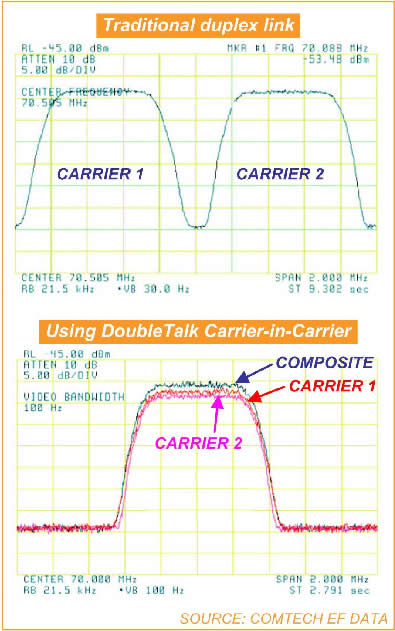| |
Advanced
Technology Enables Spectrum Sharing in Satellite Links
Broadcasters utilize satellite links for a number of applications
with the most typical being program distribution and news gathering
(SNG or satellite news gathering). Over the years, improvements
in satellite transmission technology such as higher level modulation
techniques and advanced error-correcting codes have made supporting
these applications easier and less expensive. For applications
requiring two-way (i.e. duplex) communication, the latest generation
of satellite transmission products make use of yet another technique
which can reduce the required bandwidth needed by 50%.
 This
latest advance, which some refer to as "layered modulation"
allows duplex satellite links to transmit concurrently in the
same segment of transponder bandwidth. A number of different implementations
of this technology exist, relying upon different patents. Comtech
EF Data Corporation (Tempe, AZ, www.comtechefdata.com)
utilizes "DoubleTalk Carrier-in-Carrier" patented by
Applied Signal Technology, Inc. (Sunnyvale, CA, www.appsig.com),
while ViaSat, Inc. (Carlsbad, CA, www.viasat.com)
and Paradise Datacom (www.paradisedata.com)
utilize "Paired Carrier Multiple Access" (PCMA) patented
by ViaSat. All of these technologies rely on some form of adaptive
cancellation technique to enable the sharing of spectrum by different
carriers. This
latest advance, which some refer to as "layered modulation"
allows duplex satellite links to transmit concurrently in the
same segment of transponder bandwidth. A number of different implementations
of this technology exist, relying upon different patents. Comtech
EF Data Corporation (Tempe, AZ, www.comtechefdata.com)
utilizes "DoubleTalk Carrier-in-Carrier" patented by
Applied Signal Technology, Inc. (Sunnyvale, CA, www.appsig.com),
while ViaSat, Inc. (Carlsbad, CA, www.viasat.com)
and Paradise Datacom (www.paradisedata.com)
utilize "Paired Carrier Multiple Access" (PCMA) patented
by ViaSat. All of these technologies rely on some form of adaptive
cancellation technique to enable the sharing of spectrum by different
carriers.
As an example,
consider an SNG satellite circuit where "CARRIER 1"
is the signal from the SNG truck to the studio, and "CARRIER
2" is the signal from the studio back to the SNG truck. In
a traditional configuration, these two carriers would exist side-by-side
as shown in the upper plot of the figure. With the bandwidth sharing
technology applied to this example, these carriers now utilize
one-half of the original required spectrum as illustrated by the
lower plot. Note that this lower plot is a composite of three
separate plots made by transmitting each carrier separately (in
the shared spectral location), then by transmitting the composite
carrier, and then superimposing the results from all three cases.
Here's how
it works: at each end of the link, the composite RF signal consists
of two components—the signal being transmitted (which originates
locally), and the signal being received (which originates from
the other end of the link). Since the locally-generated portion
of this signal is known, by using sophisticated digital signal
processing techniques, it is possible to estimate and remove the
contribution of the local signal from the composite signal, leaving
just the received signal which can then be demodulated in the
usual fashion.
According
to a Comtech EF Data white paper (available on the Applied Signal
Technology Web site at www.appsig.com/images/products/dt_cnc_bandwidth.pdf)
the cancellation process includes delay and frequency estimation
and tracking, adaptive filtering, and coherent combining. It continually
estimates and tracks all parametric differences between the local
uplink signal and its image within the downlink. Through proprietary
adaptive filtering and phase locked loop implementations, it dynamically
compensates for these differences by appropriately adjusting the
delay, frequency, phase and amplitude of the sampled uplink signal,
resulting in excellent cancellation performance of about 30 dB.
Some of the
transmission products now available with this technology include
the following:
- Comtech
EF Data has the CDM-625, CDM-Qx and CDM-Qxl Satellite Modems,
as well as the CLO-10 Link Optimizer, which is a "modem
agnostic" implementation and can be added to existing installations
where modems are already operating;
- Paradise
Datacom has the Quantum Series PD20 and PD20L Satellite Modems
and the PCMA-70 Bandwidth Saving Satellite Signal Canceller
(also available from ViaSat as the VPCMA-70) which is another
"modem agnostic" device designed to be added to existing
satellite facilities.
 For
additional information about this topic, Sidney Skjei, Skjei Telecom
will be presenting a paper on "New Techniques for Re-Using
Satellite Bandwidth" in the Television Infrastructure Part
I session at the 2009 NAB Broadcast Engineering Conference on
Thursday, April 23 in Las Vegas. For
additional information about this topic, Sidney Skjei, Skjei Telecom
will be presenting a paper on "New Techniques for Re-Using
Satellite Bandwidth" in the Television Infrastructure Part
I session at the 2009 NAB Broadcast Engineering Conference on
Thursday, April 23 in Las Vegas.

The
December 15, 2008 TV TechCheck is also available
in an Adobe Acrobat file.
Please click
here to read the Adobe Acrobat version of TV TechCheck.
|
|

